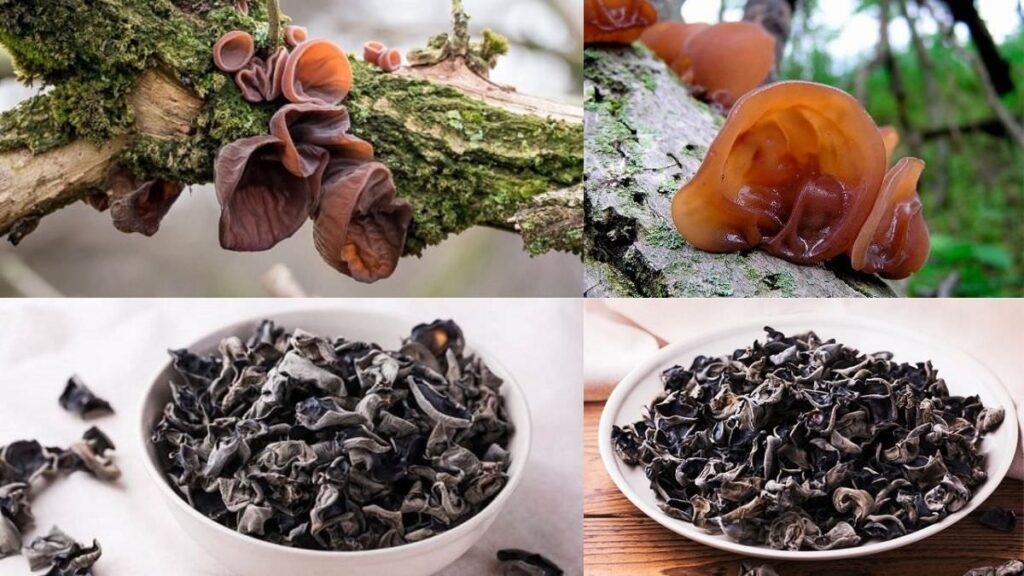Ear fungus has been the most potent fungus in Asia for centuries! Read more about the black wood ear fungus health benefits and more in this article.
History
The black wood ear fungus, botanical name Auricularia polytricha, is native to Asia and was first classified in 1753. It is classified as a wood-decaying fungus. It is a wild but edible fungus found mostly in China and tropical climates like the Pacific islands, Nigeria, Hawaii, and India. In Chinese history, it finds mention both as food and medicine, dating back to the Tang Dynasty from 618 to 907 BC.
Physical characteristics & Composition:
- It varies in color from brown to dark brown and is shaped like an ear.
- Has a rubbery texture and is wavy, wrinkled, and veined.
- Anywhere between 3 to 8 centimeters in diameter.
- Grows on tree trunks and fallen logs, found mainly growing on elder trees and dead or living spindle, ash, and beech trees.
- Composed of 90% moisture.
A serving (100g) of the fungus provides:
- Calories – 267 cal
- Carbohydrates – 73g
- Fat – 0.7g
- Protein – 9.2g
- Dietary fiber – 70g
- Potassium – 754mg
- Calcium – 16%
- Iron – 33%
- Cholesterol – 0mg
- Sodium – 35mg
- 1% Thiamine
- 50% Riboflavin
- 31% Niacin
- 6% Vitamin B6
- Zinc & copper 9 % each
- 18% Phosphorous
- 21% Magnesium
- It also contains polysaccharides, melanin, polyphenols, and alkaloids, which have health benefits.
Availability and Usage:
It ranks fourth in the list of the most widely cultivated mushrooms globally and is now also largely produced in China, Japan, Taiwan, Thailand, Indonesia, Korea, and Vietnam.
These mushrooms are cultivated in bags of sawdust and exported in the dry form. It is available in Asian grocery stores and also online. The fresh wood ear fungus lasts for up to 2 days, covered in paper towels and stored in the fridge. The dried ones will last for more than a month. You can store them in an airtight jar and keep it in a dark, dry place in your kitchen. Alternatively, you can also buy it as capsules.
Ways To Add Black Wood Ear Fungus to your Diet
- Soak the dried fungus in hot or warm water for at least half an hour and rehydrate before you cook it.
- After soaking, the mushroom expands 3 to 4 times in size.
- Before cooking, trim the hard parts of the fungus.
- It is chewy, crunchy, and has a mild musty flavor.
- It absorbs the flavor of the ingredients you add to it.
- You can drain the water in which you soaked the ear fungus and use it for other cooking purposes.
- Because of its firm and chewy quality, wood ear fungus is sought after to add a textural element in Asian and Maori cuisine, especially in soups and salads.
- You can eat it by boiling, sauting, and stir-frying. This goes well with meats as well as vegetables.
Recipe
What You Need
- Soy Sauce – 2 tbsp
- Black Vinegar – 1 tsp
- Garlic – 1/2 tbsp
- Ginger – 1/2 tbsp
- Sugar – 1/2 tbsp
- Sesame Oil – 2 tbsp
- Toasted Sesame seeds – 1 tbsp
- Wood ears – 1/2 cup
- Chopped Cucumber – 1/2 cup
- Lettuce/Celery
What To Do
- Add 2 tbsp sesame oil to a saucepan and add the ginger and garlic and cook them until they turn light brown.
- Now, add the soy sauce, black vinegar, sugar, and toasted sesame seeds and cook all of this for a minute on medium flame.
- Next, add the blanched wood ears to the saucepan and cook it thoroughly for 5 minutes on medium-low heat.
- In a separate bowl, add the chopped cucumbers and add the sauce on top of it and garnish with lettuce and celery.
Black Wood Ear Fungus Health Benefits
1. Medicinal Properties
It has been used in traditional Chinese medicine for thousands of years, but the extensive scientific study of the fungus is still in the early stages. The Chinese tout it as a medicine for sore throat, breathing problems, colds and fevers, sore eyes, and boosting immunity.
2. Helpful in Various Diseases
It has negligible fat and no sugar but is high in protein and fiber, making it a perfect option if you are on a weight loss diet or if you suffer from health conditions like diabetes. The insoluble dietary fiber in the fungus helps lower your glycemic index. It is rich in iron, which helps prevent and treat anemia.
3. Antioxidant Properties
Its high antioxidant content helps your body fight damage from free radicals, prevent chronic illnesses, and also promotes heart health. It boosts your immunity. The antioxidant property of the fungus helps protect your liver from damage from certain drugs like acetaminophen. It may also promote and maintain healthy brain function by inhibiting harmful enzymes, which cause degenerative diseases like Alzheimer’s and dementia.
4. Anti-inflammatory Properties
Its anti-inflammatory properties treat diseases like rheumatoid arthritis and also speed up wound healing. It is also high in polyphenols, which lowers your risk of cancer. It has an active component called diazane, which has anti-tumor properties. Sulfated polysaccharides in the mushroom have an antiviral effect.
5. Prebiotics
The fungus also contains prebiotics like beta-glucan that promote the growth of healthy bacteria in your gut. This improves digestion and bowel movement. They also enhance the activity of phagocytes – immune cells that protect your body by ingesting harmful bacteria. Polyphenols also help lower your LDL or bad cholesterol levels resulting in better heart health.
6. Others
The fungus also contains the pigment melanin, which protects your body from radiation. Polysaccharides in the mushroom have antimicrobial properties.
It contains significant amounts of adenosine, a chemical that inhibits blood clotting and blocks platelet aggregation. This improves blood circulation in your body and may also help prevent heart attacks and strokes.
Precautions and Side Effects:
- Do not use the fungus if it has an abnormal color or odor. Discard the fungus if it becomes slimy after soaking.
- Soak it at refrigerated temperatures because it discourages bacterial growth.
- It is better that you buy the dry fungus from a reputed retailer.
- You must soak and cook it thoroughly to avoid bacterial contamination.
- Avoid consuming wood ear fungus if you are on blood thinners.
- The fungus can also cause you to have an allergic reaction. So avoid it if you are prone to allergies. Symptoms can include skin irritation, hives, rashes, nausea, vomiting, diarrhea, cramping, swelling of the mouth, lips, throat, breathing difficulty, or can also even lead to anaphylaxis.

